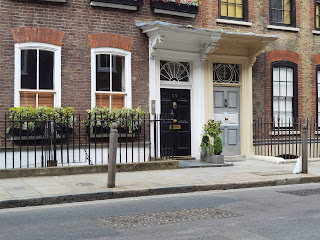Featured
- Get link
- X
- Other Apps
All locations found
Back in 2005, Google Images was only four years old but already holding a large amount of imagery that was inconceivable then yet today we think nothing of being able to have instant access to seemingly everything. Along with Google Maps, I could access satellite imagery too so I started to explore parts of the world using a combination of both. It was all new and intriguing and filled a bored half an hour here and there.
This was also a period when there was no information about any of the locations of 'The Woman in Black' were and so, one evening, I thought I would sit down to try and see if I could perhaps find the church used for Mrs. Drablow's funeral, and over several evenings across a month or so, I would list, cross out and narrow down images of Anglican churches. It felt like an impossible task, so many images to go through but one night I stopped on an image of a church that looked very familiar and, after comparing some screen shots, was delighted to find that the Church of the Holy Cross, located in Church Lane in the small village of Sarratt of the Three Rivers district in Hertfordshire, was indeed the church and churchyard used for the sequence where the woman in black is first sighted by Arthur Kidd.
Further investigating would find me uncovering Osea Island and its causeway doubling as Nine Lives Causeway as well as the village of Lacock in Wiltshire for the village of Crythin Gifford.
I excitedly added these entries to IMDB and left it there, rather pleased, and promising myself one day I would visit these places. I didn't think for a moment that I would manage to find every single location for The Woman in Black but fast-forward 17 years later, I have.
When I started researching 'Sound Haunting' in 2019, I was determined to find every location. After meeting with production designer, Jon Bunker in October of that year I was able to narrow down the geography to London and the outskirts. Not the smallest of areas but it was enough to get me started and without any sort of production paperwork to guide me, I had little choice.
Using Google Maps and Earth, an actual map of London and surrounding areas (which I would cross grid out as I explored every street on Google Street View) and some London cabbies who took my screenshots and turned it into a competition between themselves as to who would find what first on their various routes day to day, I set out to get everything.
By 2021, I had almost all locations, even the interiors of the Gifford Arms, thanks to Pauline Moran going through her old diaries and managing to give me the location and date in which a certain, quite memorable sequence was shot!
But the boating lake that closes the film was still a mystery and no-one that I had made contact with could quite remember where it was. Some thought Hampstead Heath but nothing seemed to match exactly, however, I was aware some extensive regeneration work had taken place so I assumed that perhaps the boating pond had gone.
Two weeks ago, I went back to my London map, an obsessively scrawled upon mess that had lain at the bottom of a file box for a year or so, and started looking at areas I hadn't covered. I'll admit, as I was brewing a coffee in preparation of yet another trawl through Google Earth, I wasn't looking forward to more searching as it wouldn't likely reap anything of substance but thought I would give it one last try.
About an hour into my new search I happened upon an area I hadn't seen and did include a park with a pond and island. I'd probably scanned past it several times and no doubt previously looked but decided to give it a go. Everything seemed to match instantly. I didn't get my hopes up too quickly and carefully matched some shots. And they were matching. Really well. Too well. I'd done it. I found the park, the lake, the island. Just looking the same as it did back in 1989.
All locations used in The Woman in Black are now accounted for and will feature in the book as a 'Then and Now' piece, including photographs, history of the sites and where to find them. Work begins on this in April, 2022.
- Get link
- X
- Other Apps



Comments
Post a Comment